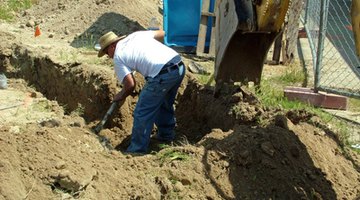How to Install Drain Pipes for a Septic Tank Yourself
Installing a septic tank generally requires a professional with the proper equipment. A concrete septic tank can weight several thousand pounds, and the average homeowner has no way of properly setting it into the hole.

Installing a septic tank generally requires a professional with the proper equipment. A concrete septic tank can weight several thousand pounds, and the average homeowner has no way of properly setting it into the hole. The field lines, however, can be installed by the homeowner, resulting in a significant cost savings.
Things You Will Need
- Shovel (backhoe preferred)
- Tape measure
- Gravel
- Rake
- PVC perforated pipe
- PVC pipe cleaner
- PVC pipe cement
- Geotextile material
- Hacksaw
Warning
Do not plant any large shrubs or trees over the drain lines.
-
Have a percolation test completed on your property. In most areas, you will need a copy of the perc test to obtain your permit to install the septic system. A licensed professional will come to your property and conduct a perc test to determine how rapidly the soil absorbs water. These results will be used to determine the amount of drain line required for your system.
-
Measure and mark out the location of the drain lines. You can break this down into multiple lines, but all lines should be the same length, and there must be a minimum of six feet between each line. Mark out the starting and ending points for each line, double checking all measurements before digging.
-
Dig each drain line 24 inches wide and 30 inches deep. While this can be done with a pick and shovel, a backhoe can make very short work of the project, saving time and sparing your back. Remove any large rocks or roots from the trenches, and keep the base as flat as possible. Each of these lines will have a pipe running to it from the distribution box. Where the pipe from the distribution box enters the ditch marks the starting point for your drain line.
-
Pour gravel into each drain line to a depth of 12 inches. Use a rake to smooth the gravel, forming a bed on which to lay your drain pipes.
-
Install a 4 inch PVC perforated pipe atop the gravel. This pipe will connect to the pipe coming from the distribution box and extend the full length of the drain line. Clean each pipe junction with pipe cleaner before applying pipe cement. Make certain all fittings are secure before moving on.
-
Pour additional gravel into the drain lines until the pipes are covered to a depth of approximately 1 to 2 inches. Rake the gravel smooth. Roll a layer of geotextile material to cover the full length and width of the drain line to prevent dirt from filtering into the drain lines and to help keep roots out of the system.
-
Back fill the drain lines, allowing for some slight mounding to offset settling, which will occur. Plant grass seed atop the drain lines to help the absorption process and prevent erosion.
The Drip Cap
- Installing a septic tank generally requires a professional with the proper equipment.
- A concrete septic tank can weight several thousand pounds, and the average homeowner has no way of properly setting it into the hole.
- Dig each drain line 24 inches wide and 30 inches deep.
- Remove any large rocks or roots from the trenches, and keep the base as flat as possible.
- Pour gravel into each drain line to a depth of 12 inches.
- This pipe will connect to the pipe coming from the distribution box and extend the full length of the drain line.
Writer Bio
Tom Raley is a freelance writer living in central Arkansas. He has been writing for more than 20 years and his short stories and articles have appeared in more than 25 different publications including P.I. Magazine, Pulsar and Writer's Digest.
Photo Credits
- construction worker image by Greg Pickens from Fotolia.com
- construction worker image by Greg Pickens from Fotolia.com
More Articles



